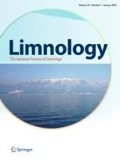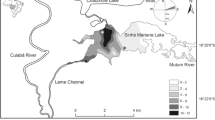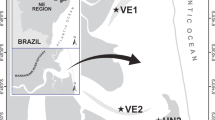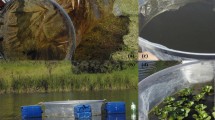Abstract
Although submerged vegetation is considered to be the most suitable refuge against predators and form of foraging habitat for small fishes, submerged plants are often scarce or lacking in turbid eutrophic lakes. To evaluate emergent (Zizania latifolia) and floating-leaved (Nelumbo nucifera) vegetation as refuge areas against predators and as foraging habitats for small fishes, we investigated the fauna, abundance, and size distribution of the fish community as well as the abundance of possible prey for small fishes in beds of each vegetation type in a eutrophic shallow lake: Lake Teganuma in Japan. The leaves and stems of N. nucifera occupied an area 4.2 times larger than that of Z. latifolia. The high coverage of the water surface with plants most likely induced the hypoxia found in the N. nucifera bed. The diversity of small fishes was greater in the Z. latifolia bed with piscivorous fish than in the N. nucifera bed without piscivorous fish. The diversity of fish species in the vegetation was enhanced when there was an increased diversity of possible food sources rather than an absence of predators. Some aquatic insects of the same species had a much lower δ13C signature at hypoxic locations than at less hypoxic locations in the N. nucifera bed. Such site differences within a bed were not observed in the organisms caught in the Z. latifolia bed. The insects in hypoxic zones with a δ13C signature lower than −30 ‰ were more depleted in 13C than the surface sediment or attached algae, suggesting that the larvae in the hypoxic zones incorporated the organic materials generated by methane-oxidizing bacteria. We can therefore conclude that floating-leaved vegetation, especially a N. nucifera bed, is not suitable as a replacement for submerged vegetation because of its potential to induce hypoxia, which can decrease the diversity of the fish fauna.



Similar content being viewed by others
References
Asaeda T, Fujino T, Manatunge J (2005) Morphological adaptations of emergent plants to water flow: a case study with Typha angustifolia, Zizania latifolia and Phragmites australis. Freshw Biol 50:1991–2001
Asama S (1989) Ecology of Lake Teganuma. Sai, Chiba (in Japanese)
Bunch AJ, Allen MS, Gwinn DC (2010) Spatial and temporal hypoxia dynamics in dense emergent macrophytes in a Florida Lake. Wetlands 30:429–435
Cazzanelli M, Warming TP, Christoffersen KS (2008) Emergent and floating-leaved macrophytes as refuge for zooplankton in a eutrophic temperate lake without submerged vegetation. Hydrobiologia 605:113–122
Chiba Prefecture (2005) Conservation project for fisheries target species in land water area. Business report of land water fisheries station for FY2004. Chiba Prefecture, Chiba, pp 7–8 (in Japanese)
Consultation Association for Conservation of Lake Teganuma (2010) Report on the Nelumbo nucifera bed at Lake Teganuma. NS Environment Co. Ltd., Tokyo (in Japanese)
Fisheries Agency (2009) Technical guideline for improvement of fisheries field in lakes. Fisheries Agency, Tokyo (in Japanese)
Gozlan RE, Andreou D, Asaeda T, Beyer K, Bouhadad R, Burnard D, Caiola N, Cakic P, Djikanovic V, Esmaeili HR, Falka I, Golicher D, Harka A, Jeney G, Kováč V, Musil J, Nocita A, Povz M, Poulet N, Virbickas T, Wolter C, Tarkan AS, Tricarico E, Trichkova T, Verreycken H, Witkowski A, Zhang C, Zweimueller I, Britton JR (2010) Pan-continental invasion of Pseudorasbora parva: towards a better understanding of freshwater fish invasions. Fish Fish 11:315–340
Jacobsen L, Perrow MR (1998) Predation risk from piscivorous fish influencing the diel use of macrophytes by planktivorous fish in experimental ponds. Ecol Freshw Fish 7:78–86
Jones RI, Grey J (2011) Biogenic methane in freshwater food webs. Freshw Biol 56:213–229
Kawanabe H, Mizuno N (1989) Freshwater fishes in Japan. Yama-kei, Tokyo (in Japanese)
Kornijów R, Strayer DL, Caraco NF (2010) Macroinvertebrate communities of hypoxic habitats created by an invasive plant (Trapa natans) in the freshwater tidal Hudson River. Fundam Appl Limnol 176:199–207
Lacoul P, Freedman B (2006) Environmental influences on aquatic plants in freshwater ecosystems. Environ Rev 14:89–136
Masstrantuono L, Mancinelli T (1999) Long-term changes of zoobenthic fauna and submerged vegetation in the shallow Lake Monterosi (Italy). Limnologica 29:160–167
Meerhoff M, Mazzeo N, Moss B, Rodriguez-Gallego L (2003) The structuring role of free-floating versus submerged plants in a subtropical shallow lake. Aquat Ecol 37:377–391
Minagawa M, Winter DA, Kaplan IR (1984) Comparison of Kjeldahl and combustion methods for measurement of nitrogen isotope ratios in organic matter. Anal Chem 56:1859–1861
Moss B, Kornijów R, Measey GJ (1998) The effects of nymphaeid (Nuphar lutea) density and predation by perch (Perca fluviatilis) on the zooplankton communities in a shallow lake. Freshw Biol 39:689–697
Nurminen L, Horppila J, Tallberg P (2001) Seasonal development of the cladoceran assemblage in a turbid lake: the role of emergent macrophytes. Arch Hydrobiol 151:127–140
Scheffer M, Hosper SH, Meijer ML (1993) Alternative equilibria in shallow lakes. Trends Ecol Evol 8:275–279
Turner AM, Cholak EJ, Groner M (2010) Expanding American lotus and dissolved oxygen concentrations of a shallow lake. Am Midl Nat 164:1–8
van Donk E, van de Bund WJ (2002) Impact of submerged macrophytes including charophytes on phyto- and zooplankton communities: allelopathy versus other mechanisms. Aquat Bot 72:61–274
Vander Zanden MJ, Rasmussen JB (1999) Primary consumer δ13C and δ15N and the trophic position of aquatic consumers. Ecology 80:1395–1404
Yasuno N, Shikano S, Muraoka A, Shimada T, Ito T, Kikuchi E (2012) Seasonal increase of methane in sediment decreases δ13C of larval chironomids in a eutrophic shallow lake. Limnology 13:107–116
Yoshimura S (1937) Limnology. Sanseidoh, Tokyo (in Japanese)
Acknowledgments
We thank Yu Tabayahsi and Hidenori Naruoka for their technical assistance. Tomoko Hiratsuka, Akihisa Katsumura, Kazuki Abukawa, Takashi Komuro, Ryotaro Nakagawa, and Takashi Hori helped with the sampling and field observations. This study was supported by the River Fund of the Foundation of River and Watershed Environment Management (FOREM), Japan.
Author information
Authors and Affiliations
Corresponding author
Additional information
Handling Editor: Yoshinori Taniguchi.
Rights and permissions
About this article
Cite this article
Yamaki, A., Yamamuro, M. Floating-leaved and emergent vegetation as habitat for fishes in a eutrophic temperate lake without submerged vegetation. Limnology 14, 257–268 (2013). https://doi.org/10.1007/s10201-013-0403-2
Received:
Accepted:
Published:
Issue Date:
DOI: https://doi.org/10.1007/s10201-013-0403-2




